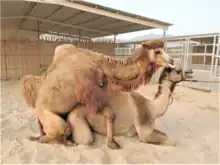Hybrid camel
A hybrid camel is a hybrid between a Bactrian camel (Camelus bactrianus) and dromedary (Camelus dromedarius).
| Hybrid camel | |
|---|---|
_x_Camelus_bactrianus_(male).webp.png.webp) | |
| F1 hybrid (tülü) | |
Domesticated | |
| Scientific classification | |
| Domain: | Eukaryota |
| Kingdom: | Animalia |
| Phylum: | Chordata |
| Class: | Mammalia |
| Order: | Artiodactyla |
| Family: | Camelidae |
| Tribe: | Camelini |
| Genus: | Camelus |
| Species: | |
Names
Hybrid camels have different names depending on zone and language. Some names include turkoman, tülu, bukht, nar, iner, iver, majen, bertuar, yaml, dromano, and dromel.
Tülu

A tülu camel is a breed of camel that results from mating a male Bactrian camel with a female dromedary. This breed is sometimes called an F1 hybrid camel. The resulting camel is larger than either a Bactrian or a dromedary, and has traditionally been used as a draft animal. This breed of camel is also the breed used in the sport of camel wrestling. Tülu camels have one large hump.
Characteristics
Generally a Camelus bactrianus × Camelus dromedarius hybrid is called an F1. It usually has a single large hump, sometimes slightly divided, and is larger than both parents, reaching 230 cm (91 in) at the shoulder and up to 1,000 kg (2,200 lb). This type of camel is extremely strong and is useful for hard work such as plowing and carrying loads. It is generally docile, tame and fertile. It was also used in war by the Ottoman Turks.
Pure camel hybrids are mostly found in Russia, Iran, Afghanistan, and Turkey; but they can be found in Saudi Arabia, Turkmenistan and Kazakhstan as well.
The F1 can be further hybridized. An F1 female can mate with a male Bactrian camel: the result is a B1 backcross Bactrian. It generally has two humps and is faster than a common Bactrian and stronger than a dromedary. It can walk over snow, ice, and mud and is suitable even for mountain trails; this type can be found mostly in Kazakhstan.
When an F1 female mates with a dromedary, the result is an B1 backcross dromedary, a slightly stronger dromedary and a rare type nowadays.
Other camelid hybridizations
References
- Amanat, Abbas (2019). Iran: a modern history. New Haven. p. 18. ISBN 978-0-300-24893-7. OCLC 1090852958.
{{cite book}}: CS1 maint: location missing publisher (link) - Lescrauwaet Vandenabiile; Anne-Cathèrine Marie Marc (1 Oct 1997). "Primera cruza interespecífica de Llama (Lama glama) y Guanaco (Lama guanicoe) como opción innovadora en la ganadería productiva de la Región de Magallanes, Chile". Observatorio para la Innovación Silvoagropecuaria y la Cadena Agroalimentaria. Retrieved 18 Nov 2021.
- Burger, Pamela Anna (2016). "The history of Old World camelids in the light of molecular genetics". Tropical Animal Health and Production. 48 (5): 905–913. doi:10.1007/s11250-016-1032-7. PMC 4884201. PMID 27048619.